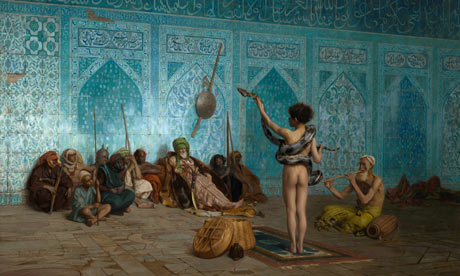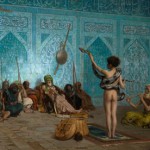译者 wizky

The Snake Charmer … JJean-Léon Gérôme’s orientalist painting is included in From Paris: A Taste for Impressionism, at the Royal Academy. Photograph: Sterling and Francine Clark Art Institute
《弄蛇人(The Snake Charmer)》……让-里奥·杰洛姆(Jean-Léon Gérôme)的东方主义画作包含于皇家艺术学会的“来自巴黎:品味印象主义(From Paris: A Taste for Impressionism)”展览中。摄影:斯特林与弗朗辛·克拉克艺术馆(Sterling and Francine Clark Art Institute)
Jean-Léon Gérôme‘s painting The Snake Charmer is a sleazy imperialist vision of “the east”. In front of glittering Islamic tiles that make the painting shimmer with blue and silver, a group of men sit on the ground watching a nude snake charmer, draped with a slithering phallic python.
让-里奥·杰洛姆(Jean-Léon Gérôme)的画作《弄蛇人(The Snake Charmer)》是对“东方”的肮脏的帝国主义看法。亮晶晶的伊斯兰风格瓷砖使整个画面闪耀着蓝色和银色的光芒,在其之前,一群人坐在地上,看着一位身上缠绕着一条巨蟒的裸身弄蛇人。
This is one of the French paintings lent by the Clark Art Institute in Williamstown, Massachusetts, to the Royal Academy for its exhibition From Paris: A Taste for Impressionism. Yet Gérôme is no impressionist. Painted in about 1879, this is a glitteringly cinematic slice of orientalist fantasy. Gérôme was the kind of painter the impressionists were rebelling against – a pristine purveyor of high-gloss dreams.
这是位于马萨诸塞州威廉斯敦的克拉克艺术馆借给皇家艺术学会作“来自巴黎:品味印象主义(From Paris: A Taste for Impressionism)”展览的众多法国画作之一。然而,杰洛姆并不是一位印象派画家。创作于1879年的这幅画是东方主义幻想中闪闪发光的一瞬。杰洛姆是印象主义者所反抗的那种画家——高光梦幻的原始供应者。
Yet his pictures are weirdly compelling: a pupil of the historical painter Paul Delaroche, whose Execution of Lady Jane Grey hangs in London’s National Gallery, he painted detailed, brilliantly lit spectacles such as gladiators fighting in the ancient Roman arena. Gérôme’s Roman empire fantasies had a direct influence on early Hollywood and still echo in modern blockbusters like Gladiator.
然而他的作品令人奇怪地引人注目:身为历史题材画家保罗·德拉罗什(Paul Delaroche)——其作品《处决“九日女王”珍·格蕾(Execution of Lady Jane Grey)》藏于伦敦的国家美术馆中——的学生,他创作了细节繁复、辉煌明亮的大场面,诸如古罗马竞技场中的角斗士搏斗。杰洛姆对罗马帝国的幻想对早期好莱坞电影有直接影响,这种影响在《角斗士》这样的现代票房巨制中仍有体现。
However, the painting by him I know best is The Snake Charmer, because it is on the cover of an old paperback copy of Edward Said’s famous book, Orientalism, which I bought ages ago as a student and happened to be looking at the other day. The Snake Charmer is such an obviously pernicious and exploitative western fantasy of “the Orient” that it makes Said’s case for him. Gérôme is, you might say, orientalism’s poster boy. In this influential work, Said analyses how Middle Eastern societies were described by European “experts” in the 19th century in ways that delighted the western imagination while reducing the humanity of those whom that imagination fed on. In The Snake Charmer, voyeurism is titillated, and yet the blame for this is shifted on to the slumped audience in the painting. Meanwhile, the beautiful tiles behind them are seen as a survival of older and finer cultures which – according to Edward Said – western orientalists claimed to know and love better than the decadent locals did.
然而,他的作品中我最了解的当属《弄蛇人》,因为这是多年前我还是学生的时候所买的一本爱德华·萨义德 (Edward Said) 的著作《东方主义(Orientalism)》平装本的封面,碰巧不久前我又重温了一遍此书。《弄蛇人》正是一种西方对“东方”的明显有害而盘剥的梦幻,以至于其正好被萨义德拿来做自身的例证。你可以说,杰洛姆是东方主义的代言人。在萨义德这本颇有影响力的著作中,他分析了19世纪的西方“专家”是如何以激发西方想象力的同时减损那些西方想象力所赖以汲取养分的人的人性的方式来描绘中东社会的。在《弄蛇人》中,窥阴癖得到了满足,而对此的指责则转嫁到画面中席地而坐的观众当中。与此同时,人群身后美丽的瓷砖被视为更古老且更出色的文明的残存之物——根据爱德华·萨义德的说法——西方的东方主义者声称他们比颓废的当地人更为了解与珍爱这样的文明。
French art in the 19th century is not only about impressionism: though it uses this rightly popular movement as a come-on in its title, the Royal Academy show glimpses the diverse styles that competed to define modern art in Paris in the later 1800s. French art in the 19th century is rich and strange, including not just the genius of Monet, but the fruity fascination of Gérôme.
19世纪的法国艺术并非仅仅是印象派:虽然皇家艺术学会使用这一大众化运动作为展览题目中的噱头,但其显示出对竞相定义19世纪后期巴黎现代艺术的多样风格的一瞥。19世纪的法国艺术博大而又奇异,不仅仅包含了莫奈(Monet)的天才,也包括了杰洛姆的内涵丰富的幻想。
![]()

本文由自动聚合程序取自网络,内容和观点不代表数字时代立场











